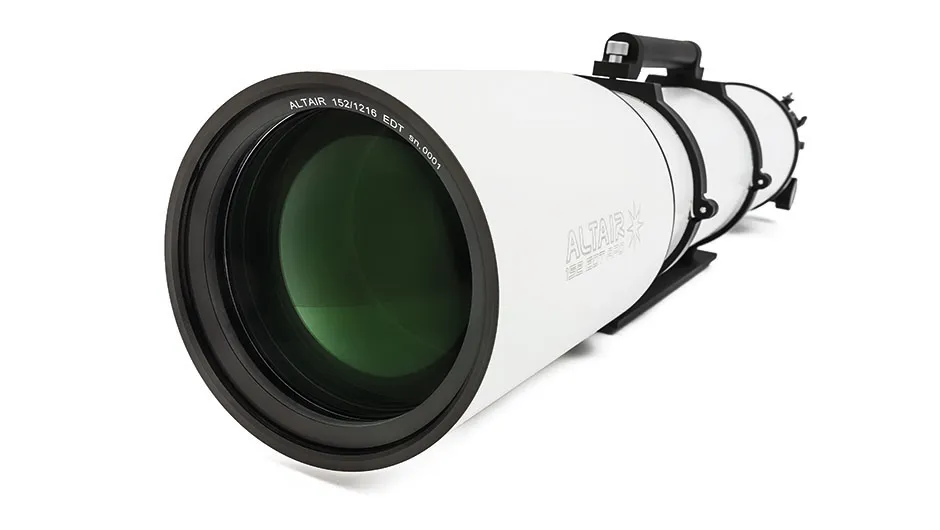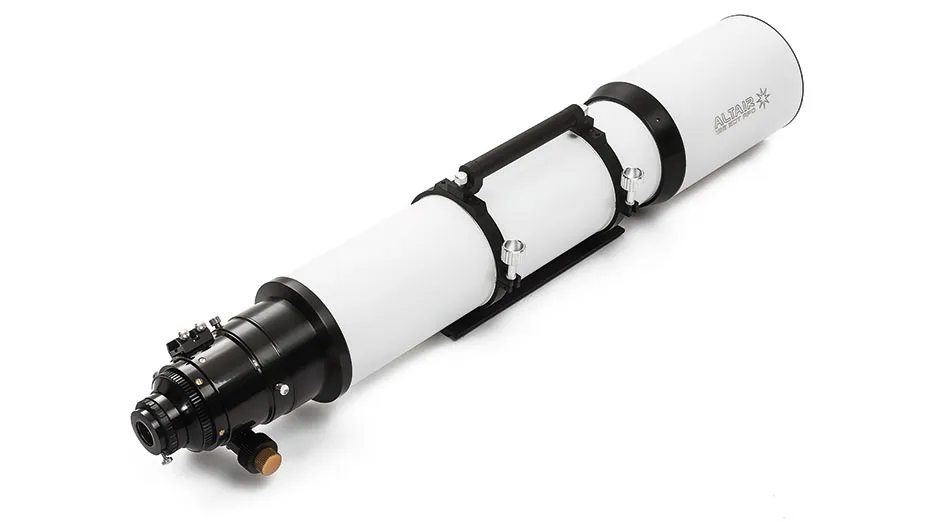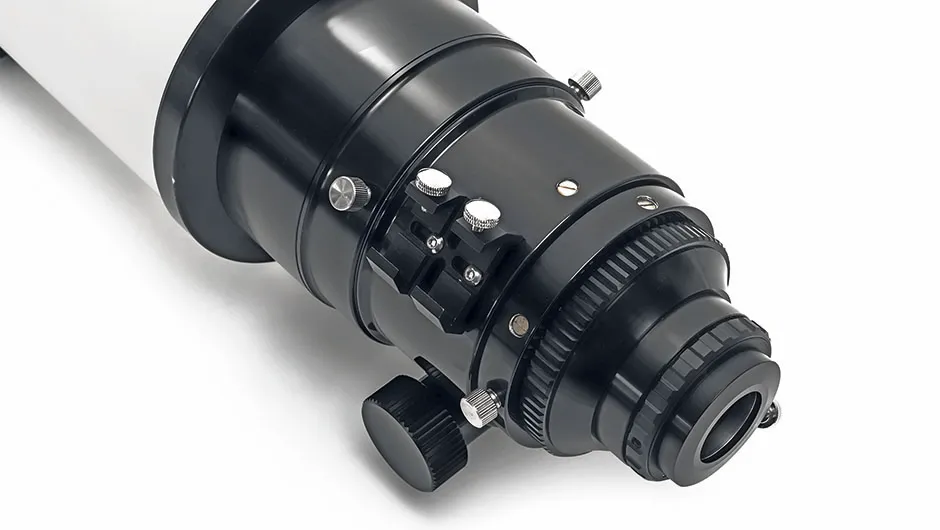Altair Astro’s 6-inch (152mm) ED f/8 triplet telescope looks and feels like a luxury telescope even before you look through the eyepiece.
Upon opening the box, the first two things you notice are its size and its weight: it’s a metre and a half long and the front lens cell is impressively hefty because it’s built from steel rather than an alloy.
The lens is made from Hoya FCD100 glass and has a built-in, extending dew shield.Tube rings and a Losmandy plate are included.
At the back end the telescope has a 3.7-inch, CNC-machined, rack-and-pinion focuser with a rotator and also a separate rotator for a camera.This contains a self-centring twist lock to hold cameras or diagonals.While this is a quick and easy method for attaching accessories, it did display a little movement.

Altair has said there will be a traditional option of a compression ring and thumbscrews for people using heavy cameras and filter wheels.
Once the telescope was mounted it becomes evident that the balance point might cause a problem for people who use a tripod as there’s a chance of this long telescope colliding with the legs.
With the dew shield fully extended and imaging equipment attached the length of the telescope exceeds 1,500cm, so this could occur even with some large mounts; it is really best suited to a pier-based system.

On a clear day, we set the telescope up for some solar viewing and imaging using a range of solar viewing eyepieces and a solar wedge.
It’s worth pointing out that any solar viewing eyepieces would need a front-mounted energy rejection filter owing to the aperture of the telescope.
While there weren’t many sunspots, the ones we did observe showed lots of detail around them and there was some nice granulation to be seen.
Switching to a camera in the magnesium wavelength we were rewarded with some nice images showing plenty of detail in prominence and sunspots.
Our next target was the Moon on view in the daytime, and we were once again rewarded with pleasing views and images.
The focuser on the telescope is a joy to use visually with your eye to the eyepiece; very smooth, it’s easy to achieve fine adjustments.We could see that a lot of thought had been put into this area and it would rival some top-end manufacturers.
Planets have not been easy to observe this year but the dust storms on Mars had started to dissipate during the review period, so we could see and image some structural detail on the Red Planet and also capture some nice detail with a mono camera and filter wheel.
Saturn produced nice clear detail around the Cassini Division and on one clear afternoon we managed to image Venus with a one-shot colour camera.

Moving to the deep sky was not without its struggles through the review period because of cloud and a bright Moon.Eventually setting up visually, we did get good views of comet 21P with nice tight stars in the eyepiece.Looking around at other targets such as star clusters and double stars, we were pleased with the views.
Currently Altair offers no dedicated flattener or reducer for deep-sky imaging but is looking into it.
With lots of changes in the camera market it’s not such a problem imaging at relatively long focal lengths these days so we set up the telescope with an 80mm guidescope and tried a few different cameras on deep-sky targets.
Using a range of imaging times from 60 seconds to three minutes for different targets, all the images had nice detail for the conditions.The Altair 152 EDT is well designed with some nice touches and good optics.If your budget allows it would be a good addition for any astronomer.
Using Hoya FCD100 glass the lens offers crisp and sharp optics for imaging and visual astronomy.The collimation screws are neatly hidden behind the dew shield.
The field of view is impressively flat to almost the corners of the image and any star distortion is only seen on the largest of camera sensors.
Imaging with an IMX 294 sensor showed the tiniest distortion in the corners of the image.The lens cell is a little different to most telescopes in that it is made of steel and not alloy.The problem with large lenses held in alloy is they can distort under rapid temperature changes.
The manufacturer has changed the design a few times and this latest innovation is a good solution to an old problem that appears to have paid off; the optics were very stable throughout the review period and needed next to no focus adjustment during imaging sessions.
The only downside is a little extra weight on the front of the telescope.
Altair Wave 152 ED triplet refractor: outstanding features
Finder shoe
The scope includes a finder shoe for attaching a finderscope.The shoe rotates with the focuser allowing the finderscope to be moved out of view of any guide equipment.For a lightweight imaging setup, the finder can also be used to mount small guiding cameras.
Tube rings
The AA152EDT features CNC-machined, lightweight aluminium tube rings that incorporate a carrying handle.The tube rings are felt-lined to stop damage to the telescope.The rings also have easy grips on top of them with smooth threads that make balancing the telescope easy.
Focuser
Focusing has been made effortless thanks to a high-quality, CNC-machined rack-and-pinion focuser accompanied by a micro focuser allowing for fine adjustments.The focuser can handle the heaviest of cameras and equipment with ease and can also be fully rotated, allowing the telescope to be mounted onto various equipment without the focus knobs getting in the way.
Losmandy plate
The Losmandy plate comes in anodised black and incorporates a 30mm centre-to-centre M6 hole spacing and a centre-slotted hole enabling multiple adjustment alignment of the tube rings.This allows for a firmer and more rigid mounting system, which is necessary when using heavier telescopes.
Dew shield
In average temperatures the built-in, retractable dew shield helps to keep invasive moisture down to a minimum.The inside of the shield is coated black to block stray light from entering the telescope.It fits snugly and firmly to the tube and is easily adjustable.
Vital stats
- Price: £4250.00
- Aperture: 6-inch
- FocalLength: 1216mm
- Weight: 15kg
- Supplier: Altair Astro
- Telephone: 01263 731505
- Website:www.altairastro.com
This review originally appeared in the November 2018 issue of BBC Sky at Night Magazine